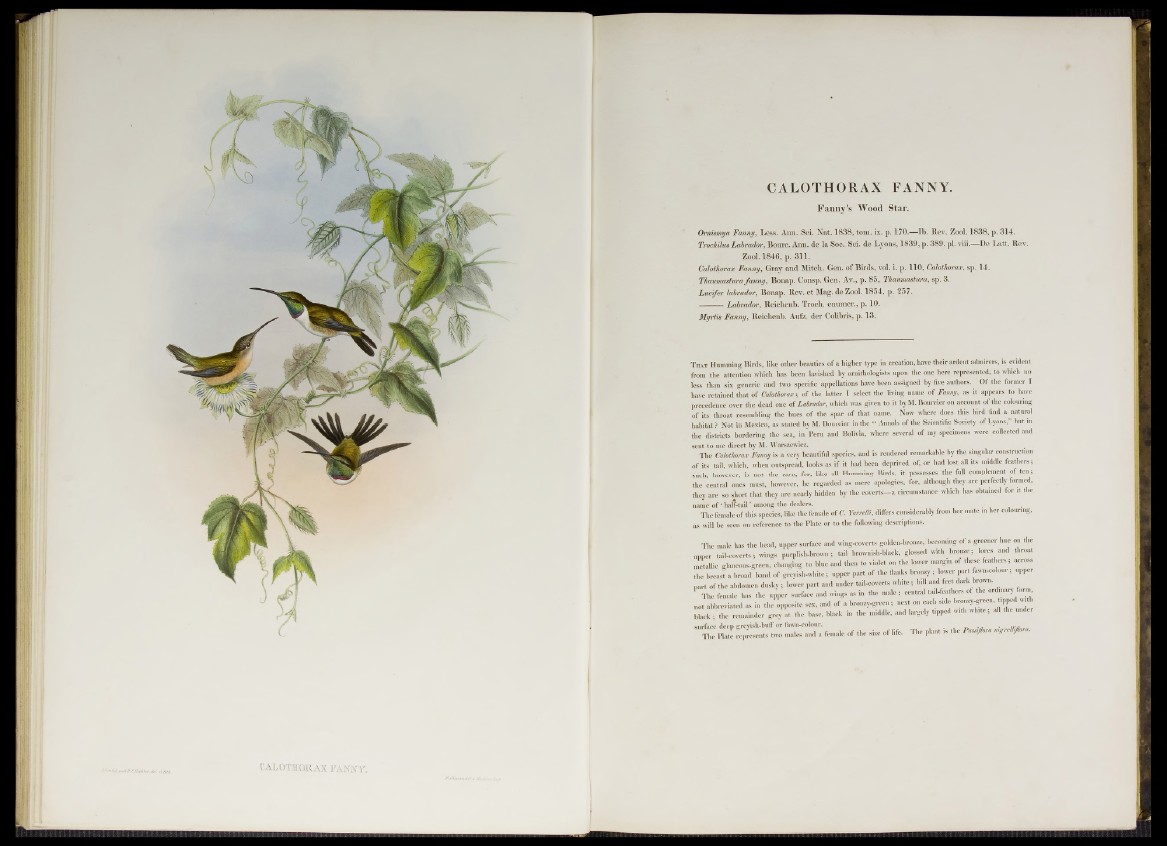
CAI.ÖTHORAX FAUSTE
CALOTHORAX FANNY.
Fanny’s Wood Star.
Omismya Fanny, Less. Ann. Sei. Nat. 1838, tom. is. p. 170.— lb. Rev. Zool. 1838, p. 314.
TrocUl-us Labrador, Bourc. Ann. de la Soc. Sci. de Lyons, 1839, p. 389. pi. viii.—De Latt. Rev.
Zool. 1846, p. 311.
Calothorax Fanny, Gray and Mitch. Gen. o f Birds, vol. i. p. 110, Calothorax, sp. 14.
Thaumastura fa n n y , Bonap. Consp. Gen. Av., p. 85, Thaumastura, sp. 3.
Lucifer labrador, Bonap. Rev. et Mag. de Zool. 1854, p. 257.
Labrador, Reichenb. Troch. enumer., p. 10.
Myrtis Fanny, Reichenb. Aofz. der Colibris, p. 13.
T hat Humming Birds, like other beauties of a higher type in creation, have their ardent admirers, is evident
from the attention which has been lavished by ornithologists upon the one here represented, to which no
less than six generic and two specific appellations have been assigned by five authors. Of the former I
have retained that of Cdlothorax; of the latter I select the living name of Fanny, as it appears to have
precedence over the dead one of Labrador, which was given to it by M. Bourcier on account of the colouring
of its throat resembling the hues of the spar of that name. Now where does this bird find a natural
habitat ? Not in Mexico, as stated by M. Bourcier in the “ Annals of the Scientific Society of Lyons,” but in
the districts bordering the sea, in Peru and Bolivia, where several of my specimens were collected and
sent to me direct by M. Warszewicz.
The Calothorax Fanny is a very beautiful species, and is rendered remarkable by the singular construction
of its tail, which, when outspread, looks as if it had been deprived of, or had lost all its middle feathers;
snch however, is not the case, for, like all Humming Birds, it possesses the full complement of ten;
the central ones must, however, be regarded as mere apologies, for, although they are perfectly formed,
they are so short that they are nearly hidden by the coverts—a circumstance which has obtained for it the
name of * half-tail ’ among the dealers.
The female of this species, like the female of C. Yarrelli, differs considerably from her mate m her colouring,
as will be seen on reference to the Plate or to the following descriptions.
The male has the head, upper surface and wing-coverts golden-bronze, becoming of a greener hue on the
upper tail-coverts; wings purplish-brown; tail brownish-black, glossed with bronze; lores and throat
metallic glaucous-green, changing to blue and then to violet on the lower margin of these feathers; across
the breast a broad hand of greyish-white; upper part of the flanks bronzy ; lower part fawn-colour; upper
part of the abdomen dusky ; lower part and under tail-coverts white; bill and feet dark brown.
The female has the upper surface and wings as in the male ; central tail-feathers of the ordinary form,
not abbreviated as in the opposite sex, and of a bronzy-green; next on each side bronzy-green, tipped wit
black ; the remainder grey at the base, black in the middle, and largely tipped with white; all the under
surface deep greyish-buff or fawn-colour. . , I I .
The Plate represents two males and a female of the size of life. The plant is the Pamflora mgrell,flora.